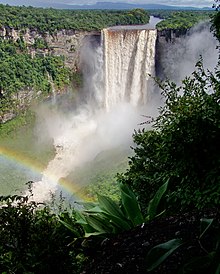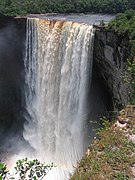Kaieteur Falls
| Kaieteur Falls | |
|---|---|
 Kaieteur Falls, Guyana, in rainy season 2004 | |
 | |
| Coordinates | 5°10′30″N 59°28′49.8″W / 5.17500°N 59.480500°W |
| Type | Plunge |
| Elevation | 4380 |
| Total height | 741 feet/226 metres |
| Number of drops | 1 |
| Longest drop | 741 feet/226 metres |
| Average width | 371 feet/113 metres |
| Watercourse | Potaro River |
| Average flow rate | 23,400 cu ft/s (660 m3/s) |
| World height ranking | 123 |
Kaieteur Falls is the world's widest single drop waterfall, located on the Potaro River in the Kaieteur National Park, in Essequibo, Guyana (Area Claimed by Venezuela). Its location is in the Amazon forest. It is 226 metres (741 ft) high when measured from its plunge over a sandstone and conglomerate cliff to the first break. It then flows over a series of steep cascades that, when included in the measurements, bring the total height to 251 metres (822 ft). While many falls have greater height, few have the combination of height and water volume, and Kaieteur is among the most powerful waterfalls in the world with an average flow rate of 663 cubic metres per second (23,400 cubic feet per second).[1]
Kaieteur Falls is about four times higher than the Niagara Falls, on the border between Canada and the United States, and about twice the height of the Victoria Falls, on the border of Zambia and Zimbabwe in Africa. It is a single drop waterfall.[2]
Upriver from the falls, the Potaro Plateau stretches out to the distant escarpment of the Pakaraima Mountains. The Potaro River empties into the Essequibo River which is one of the longest and widest rivers in South America.
Discovery
On April 24, 1870 Charles Barrington Brown, one of two British geologists appointed government surveyors to the colony of British Guiana (now known as Guyana), became the first European to see Kaieteur Falls. The other surveyor was James Sawkins. Brown and James Sawkins arrived in Georgetown in 1867 and did some of their mapping and preparation of geological reports together, some in separate expeditions, but Sawkins had taken a break from his work when Brown came upon Kaieteur.
At the time of discovery Brown did not have time to investigate Kaieteur Falls closer and he returned here one year later when measurements of the waterfall were made.
Brown’s book Canoe and Camp life in British Guiana was published in 1876. Two years later, in 1878, he published Fifteen Thousand Miles on the Amazon and its tributaries.
According to a Patamona Indian legend, Kaieteur Falls was named for Kai, a chief, or Toshao who acted to save his people by paddling over the falls in an act of self-sacrifice to Makonaima, the great spirit.
Another legend though was told to Brown by Amerindians in the night of discovery of falls: Kaieteur has been named after an unpleasant old man who was placed in a boat and shoved in the fall by his relatives. Thus the fall was named "Kaieteur" what means - "old-man-fall".
Tourism
Kaieteur Falls is a major tourist attraction in Guyana. The falls is located in Kaieteur National Park and is in the center of Guyana's rainforest. There are frequent flights between the falls airstrip and Ogle Airport and Cheddi Jagan International Airport in Georgetown.
Services
Kaieteur International Airport is located on the left bank of the Potaro river and is 6 kilometers from Kaieteur falls. The Kaieteur International Airport serves the Potaro-Siparuni regions.
Popular culture
Kaieteur Falls is featured in the documentary film The White Diamond by Werner Herzog and Animal Planet's River Monsters with Jeremy Wade.
Kaieteur Falls is featured in the science fiction animation television series G Gundam. The lead character trains and bathes under the falls before his final fight.
Kaieteur Falls is featured in the opening of the fourth season credits of the Discovery Channel's series "Gold Rush" (2013). It also features in the body of a few episodes of that season.
Kaieteur Falls is featured in episode 6 of David Attenborough's series Life on Earth in which the native frogs, which thrive in the moist conditions, are discussed.
Kaieteur Falls is featured in episode 1 of Steve Backshall's series Deadly Adventures where Steve abseils to the bottom and camps overnight.
Gallery
-
Kaieteur Falls September 2007
-
Kaietur Falls in the Dry Season, Feb 2007
References
External links
- Kaieteur National Park home to the Kaieteur Falls.
- Kaieteur Falls
- Kaieteur Falls at Beautiful World




